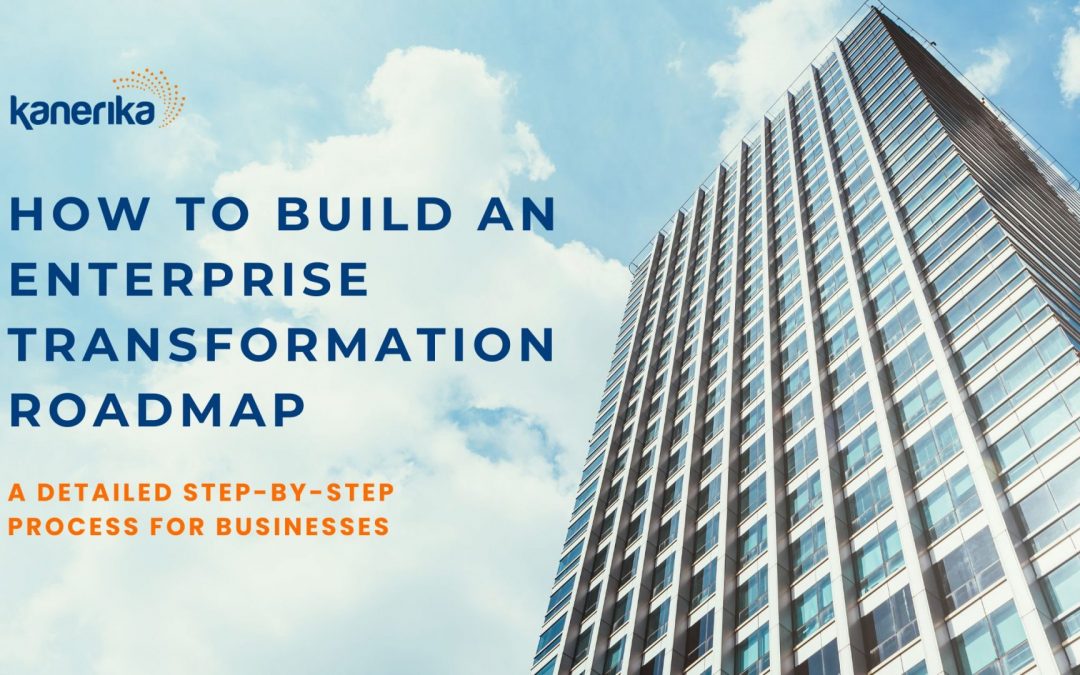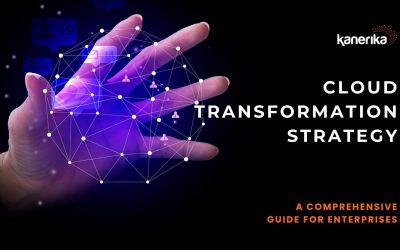Businesses are constantly changing. Companies must adapt to new market trends, consumer behavior, and technologies to avoid losing out to their competitors.
Mark Sanborn got that sentiment right when he said, “Your success in life isn’t based on your ability to change simply. It is based on your ability to change faster than your competition, customers, and business.”
Like humans have to reskill to stay relevant, companies have to make course corrections to stay afloat in an ever-changing business environment. This process is defined as enterprise transformation and has become an important part of enterprises’ long-term growth strategies.
Enterprise transformation is not just about adopting new technologies or updating business models; it’s a holistic change encompassing strategy, operations, and culture.
Consider the remarkable transformation of Microsoft under Satya Nadella’s leadership. Once known only for its Windows operating system, Microsoft pivoted towards cloud computing and AI.
Similarly, Netflix went from being a DVD rental service to a streaming giant and a leading producer of original content – a business shift that propelled Netflix to become one of the largest players in the entertainment industry.
This article will explore how to build an enterprise transformation roadmap for businesses. We will also cover industry case studies exploring its nuances, challenges, and the remarkable outcomes of its implementation.
Table of Content
- What is Enterprise Transformation?
- Business Benefits of Enterprise Transformation
- What Does an Enterprise Transformation Process Consist of?
- The 5-Step Enterprise Transformation Roadmap for Enterprises
- Kanerika Case Studies for Enterprise Transformation
- Transform Your Enterprise with Kanerika: A Partnership for the Future
- FAQs
What is Enterprise Transformation?
Enterprise transformation refers to fundamental, company-wide changes aimed at achieving significant improvements in how the organization operates.
These changes can impact different aspects of the business, such as:
- Business model: Shifting the core offering, target markets, or revenue streams.
- Organizational structure and culture: Restructuring teams, implementing new ways of working, or fostering a culture of innovation and agility.
- Technology: Adopting new tools and systems to automate processes, improve data analysis, or enhance customer experience.
- Processes: Optimizing workflows, streamlining operations, and eliminating inefficiencies.
Some common drivers of enterprise transformation include:
- Changing market dynamics: New technologies, evolving customer needs, and increased competition can necessitate changes to stay relevant.
- Disruptive innovations: Artificial intelligence, big data, and other emerging technologies can create opportunities for new business models and processes.
- Internal inefficiencies: Silos, outdated systems, and cumbersome processes can hinder performance and growth.
- Leadership vision: A strong vision for the future can inspire and guide an organization through transformational change.
Read More – Business Transformation Strategies For Enterprises in 2024
Business Benefits of Enterprise Transformation
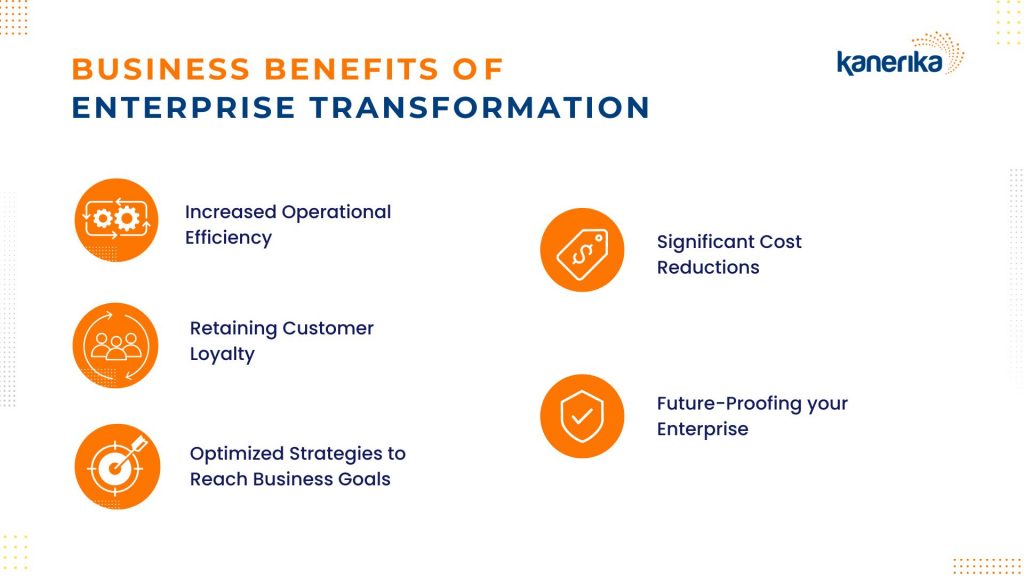
Enterprise transformation can bring a multitude of benefits to a business. These encompass its financial performance, operational efficiency, customer satisfaction, and employee engagement.
Here’s a breakdown of some key advantages:
Increased Operational Efficiency
By leveraging modern tools and optimizing processes, enterprise digital transformation can lead to a significant boost in productivity.
Employees can work faster and smarter, ultimately leading to an increase in overall output.
Streamlined workflows enhance agility and responsiveness, positioning businesses to swiftly adapt to market changes. Automated processes and improved data management play a crucial role in minimizing errors.
Retaining Customer Loyalty
With the help of data and analytics, businesses can tailor offerings and interactions to individual customer needs, fostering loyalty and advocacy.
Furthermore, a focus on enhanced customer service through improved processes and empowered employees contributes to faster issue resolution and an overall positive customer experience.
Optimized Strategies to Reach Business Goals
Enterprise transformation offers a synergistic approach where transformation initiatives and goal achievement work hand-in-hand. You don’t have to transform just for the sake of change.
Identify key goals in areas like customer experience, operational efficiency, or growth, and tailor your transformation initiatives to directly address them.
Significant Cost Reductions
When orchestrated effectively, enterprise digital transformation can become a catalyst for slashing expenses.
Robotic Process Automation (RPA) and other automation tools can take over repetitive, manual processes. It frees up valuable human resources and reduces labor costs.
At the same time, lean Six Sigma methodologies and process reengineering can eliminate inefficiencies and redundancies, minimizing wasted resources.
Future-Proofing your Enterprise
Transformation initiatives can break down rigid structures and foster a culture of experimentation.
It thus prepares your organization to navigate future uncertainties. Implementing scalable and flexible technology solutions today ensures you’re well-equipped to handle tomorrow’s data demands, security threats, and technological advancements.
What Does an Enterprise Transformation Process Consist of?

Enterprise transformation can seem like a daunting mountain to climb. It is not easy to go from making galoshes to one of the world’s most well-known brands in telecom. Nokia did it with aplomb. How do you change your organization?
Here’s a breakdown of the key steps in the process:
Planning and Transformation
Articulate a clear vision of your desired future state. What does it encompass?
You might seek to bring large changes to your product portfolio, venture into overseas markets, improve operational efficiency, or gain market share.
Of course, you cannot change it all in one go. Take the most important and conduct a thorough internal analysis to understand your current capabilities.
Optimization and Adaption
Begin by assembling a talented team, establishing clear guidelines, and maintaining open communication with your employees. By executing these aspects well, you will be able to implement an enterprise digital transformation quickly.
The actual change implementation can take a few months (say in the case of entirely revamping the IT backbone) to a few years (launching a new product and building better versions based on feedback).
Embrace a flexible approach, be ready to adapt plans based on learnings, and iterate as needed. You may need to hire external consultants who manage the change and advise you.
Control and Observation
Start with smaller, achievable initiatives that demonstrate quick wins. Establish key performance indicators (KPIs) to track progress towards your goals and assess the effectiveness of your transformation initiatives.
Strong leadership commitment and active participation are essential for driving and sustaining the transformation journey. Effective change management encompasses clear communication, stakeholder engagement, and addressing resistance to foster a smooth and successful transformation.
The key is to make haste slowly.
The 5-Step Enterprise Transformation Roadmap for Enterprises

You can’t embark on a hike on a trail without a roadmap. If you do, most likely you would wind up at a dead end and retrace your steps. It’s the same with corporate makeovers.
An enterprise transformation roadmap is an absolute necessity for navigating the complex journey of organizational change. Here are the five steps you should follow to transform your enterprise.
Step 1 – High-level Strategy Development
Begin by developing a strategy for enterprise transformation. Otherwise, your corporate transformation efforts risk being scattered, inefficient, and ultimately unsuccessful.
What are you changing? Why are you changing? What is the distance from here to there?
If you are revamping the website, upgrading CRM, or rewriting the backend, the change is relatively easy.
If you are going from being a SaaS provider of accounting software to a cloud environment behemoth with a full suite of productivity tools, the change is far harder.
Accordingly, you need to allocate resources and find a way to keep the old business running while scaling up the newer facets.
Having a strategy for enterprise digital transformation is not just about doing things right. It’s about doing the right things in the right order and within the right context.
Step 2 – Engage with Your C-Suite
The top-level management must subscribe entirely to the idea. It is not the CEO’s desire alone that can lead to change.
The CIO, CFO, CMO, and CTO all have to be on board. When you are changing, you cannot afford to have one of your principals act as a deadweight.
Depending on the change, one or more of the C-Suite teams will be more involved. A digital transformation might mean more work for the CTO and CIO and almost none for the CFO.
An expansion abroad would include more work for the CFO and CMO as they work out how taxation abroad impacts the bottom line.
As CEO, you are the arbiter in cases of disagreement. But it will take a nuanced approach to chart the course for your transformative success.
Step 3 – Define Objectives and Best Methods
Now that there is consensus about change, you need to figure out how.
This would largely depend on the aspect of business that is being changed.
For example, you want to completely overhaul ERP systems that have been in place for over a decade.
To migrate from an antiquated SAP HANA system from 2010 to the modern AI-assisted Acumatica platform, you would need to –
- Research and evaluate potential ERP vendors based on your business requirements.
- Consider scalability, user-friendliness, integration capabilities, and ongoing support.
- Plan for a comprehensive data migration strategy to transfer existing data from the old system to the new one.
- Develop a training program for employees to familiarize them with the new ERP system.
- Implement the new ERP system in phases to minimize disruptions to daily operations and so on.
Step 4 – Establish KPIs and Monitor Data
This would depend on the transformation. Some changes bear fruit almost immediately.
Digital transformation (such as changing the ERP system as outlined above) begins to deliver almost instant results.
But some corporate transformations are harder to measure, and it is natural to have doubts about progress.
Establish realistic and achievable targets for each KPI based on industry benchmarks. Hire someone from the industry you have ventured into for a better understanding.
Share with all stakeholders the progress, challenges, and successes related to the enterprise transformation.
Step 5 – Ensure Governance and Change Management
Effective governance is the bedrock of successful enterprise transformation.
As the CEO, you can help manage resistance to change by addressing concerns, providing training and support, and communicating effectively.
You need to be involved and motivate the team by leading from the front. Besides, you have the task of breaking through information silos and enhancing cooperation.
There is no single “right” way to approach agile enterprise transformation. Tailor your approach to your unique organizational context and needs.
Kanerika Case Studies for Enterprise Transformation
We know enterprise transformation can be challenging for organizations. It’s often a multi-step process that requires skilled implementation. This is where a trusted enterprise transformation partner is invaluable for organizations. Here are some case studies highlighting the transformation carried out for enterprises by Kanerika.
Case Study 1: AI Consulting for Business Value Chain
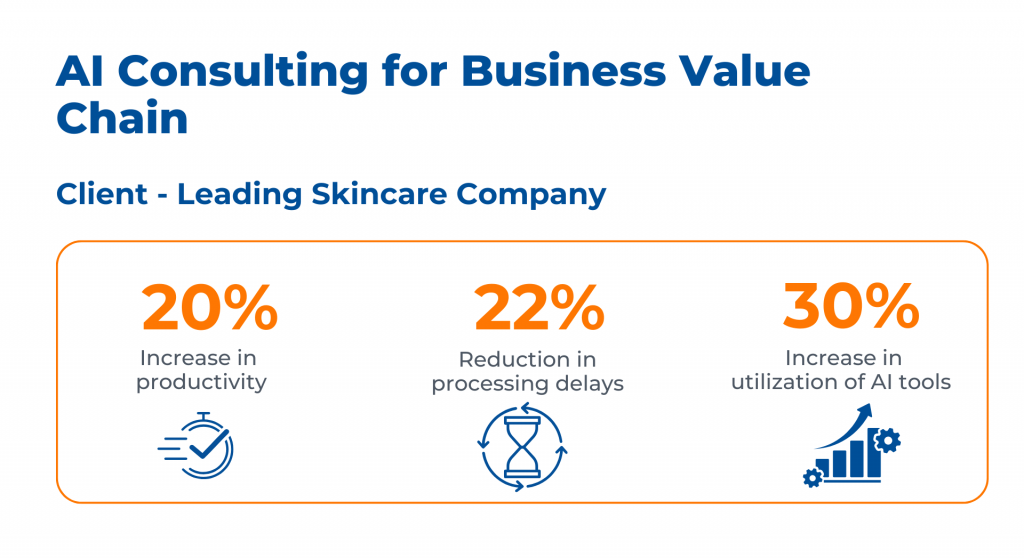
A leading skincare company faced operational inefficiencies due to the insufficient integration of AI across its business value chain.
The enterprise transformation team at Kanerika adopted a comprehensive strategy in response to these difficulties.
Robust AI prompt libraries were utilized to showcase the capabilities of advanced AI models such as GPT-4 and DALL-E/Midjourney in tackling enterprise use cases.
Engineers at Kanerika used Python along with AI/ML technologies to create a tailored solution.
The change was substantial:
- 20% increase in productivity attributed to automation.
- 22% reduction in processing delays caused by fragmented data.
- 30% increase in the utilization of AI tools and data.
Case Study 2: Data Destinations Setup for Seamless Analytics Integration
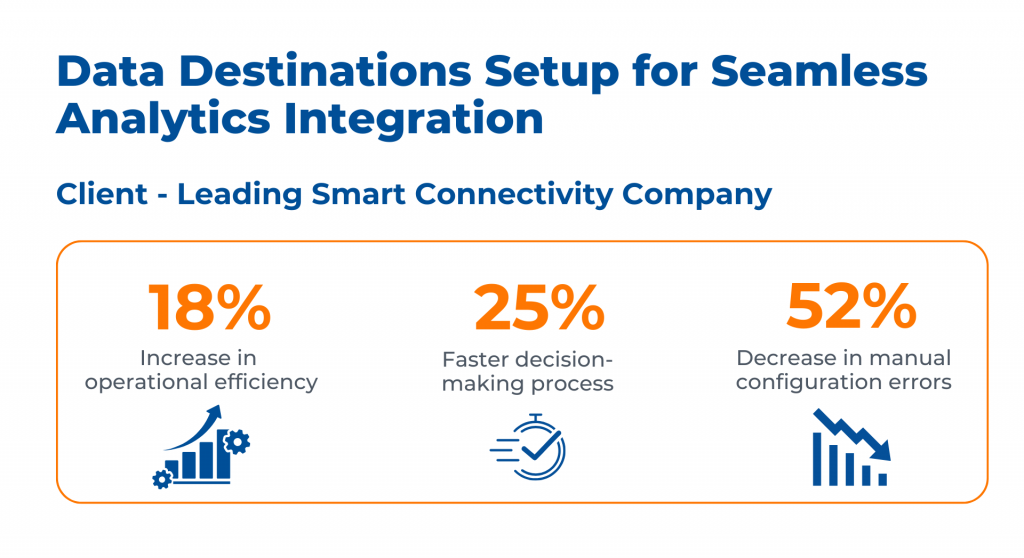
A leader in smart connectivity and mobility services faced challenges related to inconsistent data across various environments (cloud, on-prem, real-time). The manual setup of data storage systems resulted in time-consuming and error-prone processes.
Kanerika’s enterprise transformation team deployed a unique strategy. The configuration and deployment of data storage systems were automated, streamlining setup processes for enhanced operational efficiency.
Telematics data access was enabled on the enterprise analytics platform, improving visibility and decision-making capabilities.
The technological backbone of this solution included Amazon S3 and Kafka.
The results were led to a slew of improved KPIs including –
18% increase in operational efficiency, a 25% faster decision-making process, and an impressive 52% decrease in manual configuration errors.
Case Study 3: Data Consolidation and Reporting

A leading food manufacturing company encountered challenges related to inconsistent and delayed insight. This was due to dispersed SAP and non-SAP data, impeding accurate decision-making.
Synchronization issues arising from the integration of financial and HR data caused inefficiencies and errors.
Kanerika’s enterprise transformation team made changes to the system and brought in agile enterprise transformation.
Automation was introduced to integration processes, eliminating manual efforts and minimizing error risks. The integration of financial and HR data was streamlined, ensuring synchronization and enhancing overall business performance.
The technology used for this solution included Microsoft Azure and Power BI.
There was a noticeable improvement.
A 20% improvement in business performance, a remarkable 30% increase in productivity, and a significant reduction in data integration time from a monthly to a daily cycle.
Transform Your Enterprise with Kanerika: A Partnership for the Future
At Kanerika, we understand that enterprise transformation is more than a buzzword – it’s a journey that requires trust and expertise. We are committed to guiding you through every step, leveraging cutting-edge solutions and deep industry insights.
Whether it’s through streamlined processes, enhanced customer experiences, or innovative business models, our team is equipped to deliver tangible results.
Partnering with Kanerika means gaining a collaborator who is invested in your success. Our proven track record in driving digital transformation initiatives across diverse industries stands as a testament to our capability.
Don’t just adapt to change, lead it. Discover how a partnership with Kanerika can redefine your enterprise’s future.
Connect with us today and take the first step towards a transformative journey.
FAQs
What is an enterprise transformation process?
What are the 4 stages of business transformation?
- Initiation: Recognizing the need for change and starting the planning process.
- Conceptualization: Developing a strategic vision and roadmap for transformation.
- Implementation: Executing the planned changes in processes, technology, and organizational structure.
- Sustainment: Ensuring long-term success through continuous improvement and adaptation.
What is enterprise strategy and transformation?
What is enterprise-wide transformation?
What are the types of transformation processes?
- Operational Transformation: Enhancing efficiency and effectiveness of business operations.
- Digital Transformation: Integrating digital technology into all business areas.
- Cultural/Behavioral Transformation: Changing organizational culture and employee behaviors.
- Strategic Transformation: Revising the business strategy to meet new challenges.
What is enterprise strategy?
Why is transformation needed?
What are the 4 types of enterprises?
- Sole Proprietorships
- Partnerships
- Corporations
- Limited Liability Companies (LLCs)
What are the 5 components of enterprise?
- Management and Leadership
- Operations
- Human Resources
- Finance and Accounting
- Marketing and Sales

